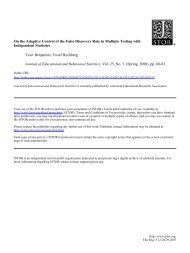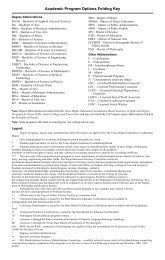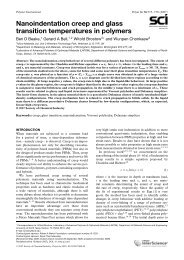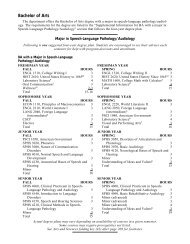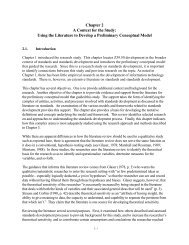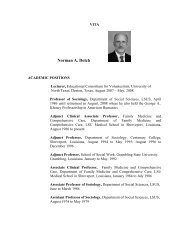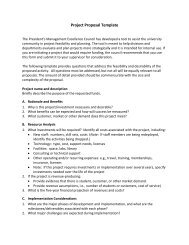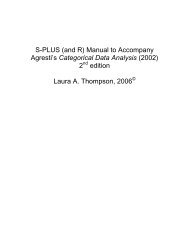Holmbeck, G. N. (1997). - Personal.kent.edu
Holmbeck, G. N. (1997). - Personal.kent.edu
Holmbeck, G. N. (1997). - Personal.kent.edu
- No tags were found...
You also want an ePaper? Increase the reach of your titles
YUMPU automatically turns print PDFs into web optimized ePapers that Google loves.
608 HOLMBECKPathways from early behavior problems, maternal control, and familystress. Development and Psychopathology, 8, 701-719.Capaldi, D. M., Crosby, L., & Clark, S. (1996, March). The predictionof aggression in young adult intimate relationships from aggressionin the family of origin: A mediational model. Paper presented at thesixth annual meetings of the Society for Research on Adolescence,Boston.Cohen, J., & Cohen, P. (1983). Applied multiple regression/correlationanalysis for the behavior sciences (2nd ed.). Hillsdale, NJ: Erlbaum.Cohen, S., & Wills, T. A. (1985). Stress, social support, and the bufferinghypothesis. Psychological Bulletin, 98, 310-357.Conger, R. D., Patterson, G. R., & Ge, X. (1995). It takes two to replicate:A mediational model for the impact of parents' stress on adolescentadjustment. Child Development, 66, 80-97.Colder, C.R., Chassin, L., Stice, E.M., & Curran, P.J. (in press).Alcohol expectancies as potential mediators of parent alcoholism effectson the development of adolescent heavy drinking. Journal ofResearch on Adolescence.Colder, C. R., Lochman, J. E., & Wells, K. C. (in press). The moderatingeffects of children's fear and activity level on relations between parentingpractices and childhood symptomatology. Journal of AbnormalChild Psychology.Conrad, M., & Hammen, C. (1993). Protective and resource factors inhigh- and low-risk children: A comparison of children with unipolar,bipolar, medially ill, and normal mothers. Developmental Psychopathology,5, 593-607.Cummings, E. M., Davies, P. T., & Simpson, K. S. (1994). Marital conflict,gender, and children's appraisals and coping efficacy as mediatorsof child adjustment. Journal of Family Psychology, 8, 141-149.Davies, P. T, & Cummings, E. M. (1995). Children's emotions as organizersof their reactions to interadult anger: A functionalist perspective.Developmental Psychology, 31, 677-684.Eckenrode, J., Rowe, E., Laird, M., & Brathwaite, J. (1995). Mobilityas a mediator of the effects of child maltreatment on academic performance.Child Development, 66, 1130-1142.Evans, M. G. (1991). The problem of analyzing multiplicative composites:Interactions revisited. American Psychologist, 46, 6-15.Farrell, A. D. (1994). Structural equation modeling with longitudinaldata: Strategies for examining group differences and reciprocal relationships.Journal of Consulting and Clinical Psychology, 62, 477-487.Fauber, R., Forehand, R., Thomas, A. M., & Wierson, M. (1990). Amediational model of the impact of marital conflict on adolescentadjustment in intact and divorced families: The role of disrupted parenting.Child Development, 61, 1112-1123.Feldman, S. S., & Weinberger, D. A. (1994). Self-restraint as a mediatorof family influences on boys' delinquent behavior: A longitudinalstudy. Child Development, 65, 195-211.Felner, R. D., Brand, S., DuBois, D. L., Adan, A. M., Mulhall, P. F., &Evans, E. G. (1995). Socioeconomic disadvantage, proximal environmentalexperiences, and socioemotional and academic adjustment inearly adolescence: Investigation of a mediated effects model. ChildDevelopment, 66, 774-792.Folkman, S., & Lazarus, R. S. ( 1991 ). Coping and emotion. In A. Monat& R. S. Lazarus (Eds.), Stress and coping: An anthology (3rded., pp. 207-227). New York: Columbia University Press.Frank, S., & Jackson, S. (1996). Family experiences as moderators ofthe relationship between eating symptoms and personality disturbance.Journal of Youth and Adolescence, 25, 55-72.Frese, M. (1986). Coping as a moderator and mediator between stress atwork and psychosomatic complaints. In M. H. Appley & R. Trumball(Eds.), Dynamics of stress: Physiological, psychological, and socialperspectives (pp. 183-206). New York: Plenum.Friedrich, R. J. (1982). In defense of multiplicative terms in multipleregression equations. American Journal of Political Science, 26, 797-833.Fuhrman, T, & <strong>Holmbeck</strong>, G. N. (1995). A contextual moderator analysisof emotional autonomy and adjustment in adolescence. Child Development,66, 793-811.Grych, J. H., & Fincham, F. D. (1990). Marital conflict and children'sadjustment: A cognitive-contextual framework. Psychological Bulletin,108, 267-290.Hackworth, S. R., & McMahon, R. J. (1991). Factors mediating children'shealth care attitudes. Journal of Pediatric Psychology, 16, 69-85.Hamlett, K.W., Pellegrini, D.S., & Katz, K.S. (1992). Childhoodchronic illness as a family stressor. Journal of Pediatric Psychology,17, 33-47.Hanson, C. L., Henggeler, S. W., & Burghen, G. A. (1987). Social competenceand parental support as mediators of the link between stressand metabolic control in adolescents with insulin-dependent diabetesmellitus. Journal of Consulting and Clinical Psychology, 55, 529-533.Harnish, J. D., Dodge, K. A., & Valente, E. (1995). Mother-child interactionquality as a partial mediator of the roles of maternal depressivesymptomatology and socioeconomic status in the development of childbehavior problems. Child Development, 66, 739-753.Holahan, C. J., Valentiner, D. P., & Moos, R. H. (1995). Parental support,coping strategies, and psychological adjustment: An integrativemodel with late adolescents. Journal of Youth and Adolescence, 24,633-648.<strong>Holmbeck</strong>, G. N. (1989). Masculinity, femininity, and multiple regression:Comment on Zeldow, Daugherty, and Clark's "Masculinity, femininity,and psychosocial adjustment in medical students: A 2-yearfollow-up." Journal of <strong>Personal</strong>ity Assessment, 53, 583-599.<strong>Holmbeck</strong>, G. N. (1996). A model of family relational transformationsduring the transition to adolescence: Parent-adolescent conflict andadaptation. In J. A. Graber, J. Brooks-Gunn, & A. C. Petersen (Eds.),Transitions through adolescence: Interpersonal domains and context(pp. 167-199). Mahwah, NJ: Erlbaum.Hoyle, R. H. (Ed.). (1995). Structural equation modeling: Concepts,issues, and applications. Thousand Oaks, CA: Sage.Hoyle, R.H., & Smith, G.T. (1994). Formulating clinical researchhypotheses as structural equation models: A conceptual overview.Journal of Consulting and Clinical Psychology, 62, 429-440.Ireys, H. T., Werthamer-Larsson, Kolodner, K. B., & Gross, S. S. (1994).Mental health of young adults with chronic illness: The mediatingeffect of perceived impact. Journal of Pediatric Psychology, 19, 205-222.Jaccard, J., Turrisi, R., & Wan, C.K. (1990). Interaction effects inmultiple regression. Newbury Park, CA: Sage.Jaccard, J., & Wan, C. K. (1995). Measurement error in the analysisof interaction effects between continuous predictors using multipleregression: Multiple indicator and structural equation approaches.Psychological Bulletin, 117, 348-357.Jaccard, J., & Wan, C. K. (1996). L1SREL approaches to interactioneffects in multiple regression. Thousand Oaks, CA: Sage.James, L. R., & Brett, J. M. (1984). Mediators, moderators, and testsfor mediation. Journal of Applied Psychology, 69, 307-321.Jessor, R., Van Den Bos, J., Vanderryn, J., Costa, F. M., & Turbin, M. S.( t 995 ). Protective factors in adolescent problem behavior: Moderatoreffects and developmental change. Developmental Psychology, 3l,923-933."J6reskog, K., & S6rbom, D. (1993). LISREL VIII. Chicago: ScientificSoftware.J6reskog, K., & Yang, F. (1996). Nonlinear structural equation models:The Kenny-Judd model with interaction effects. In G. Marcoulides &R. Schumacker (Eds.), Advanced structural equation modeling (pp.57-88). Hillsdale, NJ: Erlbaum.Jose, P. E., Cafasso, L. L., & D'Anna, C. A. (1994). Ethnic group differencesin children's coping strategies. Sociological Studies of Children,6, 25-53.



